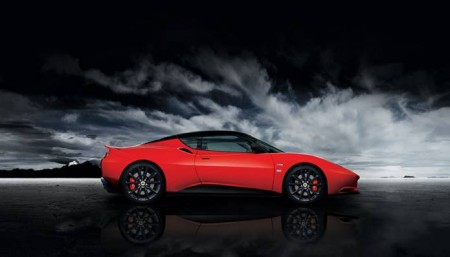It’s been a busy year for Lotus; the arrival of the acclaimed Exige S; featured marque at the Goodwood Festival of Speed; a new flagship retail store in Regent Street; third place in the F1 Drivers’ Championship and fourth in the F1 Constructors’ Championship; and amongst various racing exploits, another series win for a Lotus with an Evora GTC taking the MSA British Endurance Championship.
Following the excitement of this race series win, the new Evora ‘Sports Racer’ is a visually enhanced and optimised version of the mid-engined 3.5 litre V6 sports car, available in both naturally-aspirated or supercharged variants. The Evora ‘Sports Racer’ proves its value on the pocket, as well as on the road and track – it delivers phenomenal performance, exclusive style, incredible excitement and genuine affordability!
There are three main factors that set the ‘Sports Racer’ apart from the existing Evora range; firstly, it receives a unique exterior colour scheme with an optimised interior to match. Secondly, it comes fully loaded, boasting Lotus’ ultimate specification. While thirdly, it’s more affordable than ever, representing great value. Here’s the detail:
Aesthetics:
The Evora ‘Sports Racer’ is available in a choice of four colours: Aspen White, Carbon Grey, Nightfall Blue and Ardent Red. To stand out from the crowd, the ‘Sports Racer’ receives unique contrasting accents of gloss black across the roof, front splitter, rear diffuser and side sills, exaggerating the Evora’s aggressive stance and sleek silhouette. Further black elements include black rear badging, black door mirror pods and gloss black forged wheels with a choice of either red or black brake calipers which all work to give the ‘Sports Racer’ a more dramatic and focused appearance.
Inside, the 2+2 seating option is standard and comes adorned with black leather ‘Premium Sports’ seats trimmed with red contrast piping and stitching. The dash, doors and centre console receive a liberal dose of Slate Grey SuedeTexTM with red contrast stitching, highlighting the car’s sporting character.
Like your interiors a bit louder? Go for Venom Red leather ‘Premium Sports’ seats with black contrast piping and stitching. All Evora ‘Sport Racer’ interiors are complemented by gunmetal dashboard panels, as is standard in the Evora S.
Gadgets:
The Evora ‘Sports Racer’ comes loaded with optional extras as standard. The ‘Sports Pack’ provides switchable sports mode with sharper throttle response, increased rpm limit and sportier setting for Dynamic Performance Management (DPM), sports diffuser and cross-drilled brake discs. The ‘Tech Pack’ provides upgraded speakers and stereo system, DVD player, 7″ WVGA touch screen display, Bluetooth® mobile phone connection, USB connection for various iPod® models, MP3 players and memory sticks, tyre pressure monitoring, cruise control and rear parking sensors. This is topped of with electric power-fold mirrors and a reversing camera as standard.
Price:
Available in the UK and across Europe, the Evora ‘Sports Racer’ adds outstanding value to the already exceptional Evora range, priced in the UK at £57,900* for the Evora with 280 PS or £65,900* for the 350 PS supercharged Evora S. For UK customers, the cost benefits are clear; by opting for the pre-packaged Evora ‘Sports Racer’ savings range from £6,450 to £7,150 respectively.
Lotus Evora race cars
This year Team Bullrun won the title in the MSA British Endurance Championship in the newly developed Evora GTC and Alex Job Racing has been enjoying success in the ALMS series with the Evora GTE. Meanwhile, the Evora GT4 has been racing successfully in the Brazilian GT, the Iberian Supercar Trophy, Campeonato de España/IBER GT, Cameonato de Portugal GT, the Dutch GT championship and 24 hour races in Dubai, Barcelona and at Silverstone. The Evora GT4 is also competing in Lotus Cup series across the globe.
Press release from Lotus

